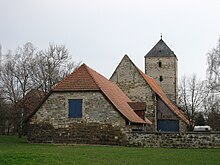Tax forest office
The tax forest office was a historical administrative area of the Hochstift Hildesheim and the Kingdom of Hanover .
history
The office goes back to the eponymous bishop's castle in Steuerwald , which was built around 1310/13 and served to supply the residence until the prince's bishopric was secularized , which is why it was mostly administered by episcopal bailiffs and was not pledged. It only came into the hands of aristocratic believers in the 16th century (most recently Rudolf von Rauschenplat). Bishop Friedrich von Schleswig-Holstein managed to redeem his office in 1554 with financial support from his brothers. When, after his death (1556), the Catholic monastery dean Burchard von Oberg was elected as the new bishop, Friedrich's brother Adolf I of Schleswig-Holstein kept the office under his control. In 1562 he introduced a reformatory church order for the offices of Steuerwald and Peine . It was not until the spring of 1564 that Bishop Burchard was able to redeem the office again and began carrying out the Counter Reformation, which brought almost the entire area back to the Catholic Confession. The communities of Barnten and Giften, however, remained Lutheran.
In 1802 the office with the Hildesheim monastery became Prussian, later it came under French-Westphalian rule. After the annexation to the Kingdom of Hanover (1815) it was restituted in its old size, but in 1823 it was merged with the Marienburg Office to the Tax Forest-Marienburg Office. At the same time, the bailiwick of Nettlingen, with the exception of the village of Wendhausen, was separated and added to the Steinbrück office . In 1844 the office was combined with the Hildesheim office .
scope
The office was ultimately composed of the house bailiff and two official bailiffs. They comprised (1823) the following communities and places to live:
- House bailiwick: Barnten, Emmerke, Groß and Klein Escherde, Giften, Groß and Klein Giesen, Himmelsthür and Sorsum, domain Steuerwald, the farms Entenfang, Lademühle and Posthof.
- First district bailiff: Achtum with Uppen, Ahrbergen, Bavenstedt, Bettmar, Dinklar, Drispenstedt, Einum, Groß and Klein Förste, Kemme and the Bierbrock tavern
- Second district bailiwick: Ahstedt, Dingelbe, Ottbergen, Schellerten, Wendhausen and Wöhle.
Drosten and bailiffs
Drosten
- 1581–1583: Ashes of Holle
...
- 1697–1722: Franz Johann Rudolf von Wobersnow
- 1722–1758: Ingnatius Franz Friedrich von Weichs
- 1758–1768: Franz Stephan von Weichs
- 1768–1802: Ludwig Benedikt von Gemmingen
Bailiffs
- -1563: Matthias Schilling
- 1564–1580: Heinrich Braunschweig
- 1580–1593: Jobst Hadeler
- 1593–1598: Eberhard von Essen
- 1598–1604: Heinrich Borgentreich
- 1604–1609: Heinrich Gellern
- 1609–1626: Johann Flöckher
- 1627–1634: Sievert Heister
- 1634–1643: Ludolf Behling
- 1643–1649: Sievert Heister
- 1649–1662: Johannes Bucholtz
- 1662–1697: Johann Gottfried Buchholtz
- 1697–1713: Johann Friedrich Nicolartz
- 1713–1724: Joachim Heinrich (von) Hermanni
- 1725–1733: Johann Heinrich Cordes
- 1733–1757: Johann Ferdinand von Fumetti
- 1758–1766: Franz Anton Weber
- 1766–1780: Caspar Engelbert Tils
- 1780–1802: Franz Joseph Schnurbusch
- 1802–1806: Wilhelm Max Zeppenfeldt
- 1806–1813: Wilhelm Pfingsthorn
- 1815–1817: Arnold Busch, tit. Bailiff (by order)
- 1818–1844: Joseph Max Grebe, bailiff
literature
- Iselin Gundermann , Walther Hubatsch : Outline of the German administrative history 1815-1945 . Row A: Prussia, Volume 10: Hanover. Marburg (Lahn) 1981
- Manfred Hamann : Overview of the holdings of the Lower Saxony Main State Archives in Hanover. Third volume: Central and subordinate authorities in the Landdrostei and administrative districts of Hanover, Hildesheim and Lüneburg until 1945. Göttingen 1983, p. 300f.
- Thomas Klingbiel: A stand of its own? Local officials in the early modern period: Studies on state formation and social development in the Hildesheim Monastery and in the older Principality of Wolfenbüttel . Hannover 2002, pp. 697-709
